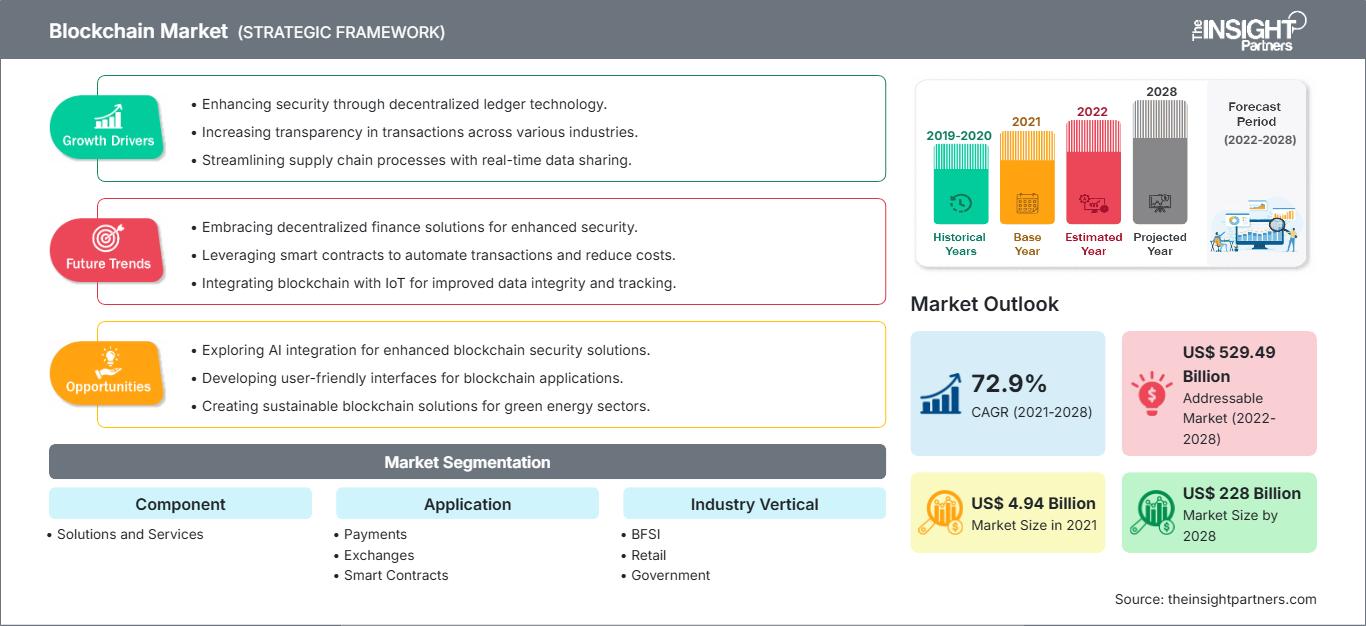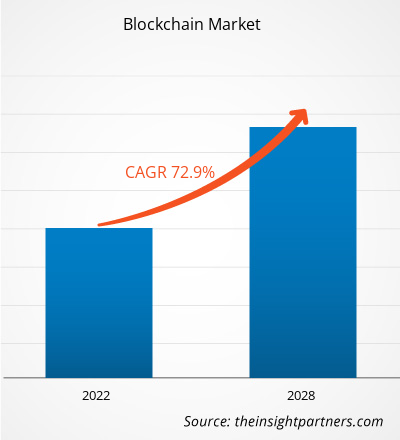Le marché de la blockchain devrait passer de 4 935 millions de dollars américains en 2021 à 227 996,6 millions de dollars américains d'ici 2028 ; sa croissance est estimée à un TCAC de 72,9 % entre 2021 et 2028. La technologie blockchain et ses applications dans le secteur de la banque, des services financiers et de l'assurance (BFSI) ont suscité un vif intérêt ces dernières années, principalement en raison de sa capacité à transformer les fondements et les modèles économiques des industries existantes. Actuellement, outre les applications liées aux cryptomonnaies, les autres applications pratiques majeures de la blockchain se situent toujours dans le secteur bancaire et financier ; cependant, diverses entreprises et institutions développent rapidement des solutions basées sur la blockchain pour résoudre des problèmes commerciaux complexes. De manière générale, la blockchain est un sous-ensemble d'une technologie de registre distribué (DLT) plus large et combine trois concepts importants : la cryptographie, les contrats intelligents et la conception de registres distribués. La technologie des registres distribués (DLT) est une approche en plein essor qui permet d'enregistrer et de partager des données entre différents entrepôts/registres de données. La DLT facilite l'enregistrement, le partage et la synchronisation des transactions et des données sur un réseau distribué regroupant différents participants.
Le marché mondial de la blockchain devrait connaître une très forte croissance dans un avenir proche. Parmi les principaux moteurs de cette croissance figurent l'adoption massive des solutions blockchain dans le secteur des BFSI ; des avantages tels qu'une plus grande transparence, une plus grande efficacité opérationnelle et des économies de coûts substantielles ; et une augmentation du nombre de startups innovantes. Au cours de la période de prévision, des tendances telles que le soutien et les initiatives gouvernementaux croissants, ainsi que l'association de la blockchain et de l'intelligence artificielle pour des applications avancées, devraient offrir des opportunités prometteuses aux acteurs du marché de la blockchain.
Personnalisez ce rapport en fonction de vos besoins
Vous bénéficierez d’une personnalisation sur n’importe quel rapport - gratuitement - y compris des parties de ce rapport, ou une analyse au niveau du pays, un pack de données Excel, ainsi que de profiter d’offres exceptionnelles et de réductions pour les start-ups et les universités
Marché de la blockchain: Perspectives stratégiques

- Obtenez les principales tendances clés du marché de ce rapport.Cet échantillon GRATUIT comprendra une analyse de données, allant des tendances du marché aux estimations et prévisions.
Impact de la pandémie de COVID-19 sur le marché de la blockchain
Si la pandémie de COVID-19 a posé des problèmes importants aux organisations du monde entier, le marché de la blockchain a connu une croissance constante pendant la crise. Plus important encore, tout au long de l'épidémie, les professionnels de santé ont adopté les chats, les e-mails, les téléphones et les conversations vidéo pour traiter les patients à distance, empêchant ainsi la propagation du virus. L'utilisation d'outils de tests d'intrusion pour sécuriser les transactions en ligne et les données conversationnelles a augmenté en conséquence. L'adoption du marché de la blockchain par diverses entreprises pour assurer une sécurité optimale dans un environnement chaotique est également un élément crucial qui stimule le marché de la blockchain. La pandémie de COVID-19 a eu un impact sur tous les aspects de la société, y compris les particuliers et les entreprises. L'écosystème Internet a pris une importance croissante à l'échelle mondiale. La dépendance aux entreprises en ligne s'est considérablement accrue en raison de l'épidémie de COVID-19. Internet est utilisé par les entreprises de services financiers et d'investissement, les secteurs de la santé et des sciences de la vie, de l'industrie manufacturière, de la vente au détail, du transport et de la logistique, et d'autres secteurs pour fournir des services essentiels aux consommateurs. La demande de blockchain a explosé parmi les fournisseurs. Divers gouvernements et organismes de réglementation ont contraint les organisations publiques et privées à adopter de nouvelles techniques de télétravail et de maintien de la distanciation sociale suite à la pandémie de COVID-19. Depuis lors, les pratiques commerciales numériques et l'utilisation des e-mails sur les serveurs domestiques sont devenues le nouveau plan de continuité des activités (PCA) pour de nombreuses entreprises. Vous bénéficierez d’une personnalisation sur n’importe quel rapport - gratuitement - y compris des parties de ce rapport, ou une analyse au niveau du pays, un pack de données Excel, ainsi que de profiter d’offres exceptionnelles et de réductions pour les start-ups et les universités
Marché de la blockchain: Perspectives stratégiques

- Obtenez les principales tendances clés du marché de ce rapport.Cet échantillon GRATUIT comprendra une analyse de données, allant des tendances du marché aux estimations et prévisions.
Informations sur le marché de la blockchain
Des secteurs d'activité de premier plan à travers le monde, notamment la banque, les services financiers et les assurances (BFSI) ; la vente au détail ; la logistique et les transports ; la santé ; l'automobile ; les médias et le divertissement ; et les organisations du secteur public, intègrent de plus en plus des technologies disruptives telles que la blockchain, l'intelligence artificielle (IA), l'Internet des objets (IoT), le big data et l'analyse prédictive à leurs opérations. Parmi ces technologies, la blockchain s'est imposée comme une force transformatrice, largement adoptée grâce à sa capacité avérée à offrir une plus grande transparence, à améliorer l'efficacité opérationnelle et à réduire les coûts transactionnels et administratifs. L'adoption accélérée de la blockchain est soutenue par un nombre croissant de déploiements réussis et de programmes pilotes qui démontrent des avantages concrets. Les entreprises sont confrontées à une pression croissante pour maintenir leur compétitivité dans une économie numérique en rapide évolution, et la blockchain offre une infrastructure décentralisée, sécurisée et inviolable qui répond à cet impératif. De plus, les entreprises reconnaissent la valeur stratégique de la blockchain, car elle permet des opérations plus agiles, axées sur les données, et renforce la confiance entre les parties prenantes. Dans le secteur des services financiers, la blockchain a trouvé de nombreuses applications dans des domaines tels que les paiements transfrontaliers, les marchés de capitaux, le financement du commerce extérieur, la gestion des investissements et du patrimoine, ainsi que la compensation et le règlement-livraison de titres. Sa capacité à rationaliser et automatiser des processus traditionnellement manuels et chronophages réduit la dépendance aux intermédiaires, diminue considérablement les délais de traitement et minimise les risques d'erreurs et de fraude. De plus, les organisations manipulant des données sensibles, comme les secteurs de la santé et des administrations publiques, exploitent la blockchain pour garantir l'intégrité des données et sécuriser le partage d'informations. En offrant des pistes d'audit immuables et un accès aux données en temps réel, la blockchain améliore la conformité réglementaire et renforce la confiance entre tous les acteurs de tout écosystème de marché. La réduction des coûts opérationnels reste un objectif central pour les entreprises du monde entier. La blockchain contribue à cet objectif en optimisant l'efficacité des flux de travail et en éliminant les processus de vérification redondants. Alors que les entreprises poursuivent leurs stratégies de transformation numérique, la blockchain se positionne comme un moteur clé de l'innovation. Elle améliore l'expérience client grâce à des services plus rapides, une meilleure précision des données et une responsabilisation renforcée, la positionnant comme un atout à long terme pour la résilience et l'évolutivité des entreprises.Informations sur les segments de composants
Le marché de la blockchain peut être divisé en services et en solutions. Le segment des solutions a dominé le marché de la blockchain. L'adoption croissante des solutions blockchain, grâce à leur capacité à offrir plus de transparence dans la gestion des transactions financières en bitcoins, ainsi que la numérisation croissante, propulsent le marché de la blockchain vers l'avant. Les clients peuvent utiliser la plateforme blockchain du marché pour créer des environnements blockchain privés, publics et basés sur des consortiums, et construire leurs propres applications et solutions blockchain. Les personnes, les produits, les applications et les services peuvent interagir sur le réseau blockchain, les fournisseurs de cloud et les entreprises utilisant ces plateformes.Aperçu régional du marché de la blockchain
Les tendances régionales et les facteurs influençant le marché de la blockchain tout au long de la période de prévision ont été analysés en détail par les analystes de The Insight Partners. Cette section aborde également les segments et la géographie du marché de la blockchain en Amérique du Nord, en Europe, en Asie-Pacifique, au Moyen-Orient et en Afrique, ainsi qu'en Amérique du Sud et en Amérique centrale.
Portée du rapport sur le marché de la blockchain
| Attribut de rapport | Détails |
|---|---|
| Taille du marché en 2021 | US$ 4.94 Billion |
| Taille du marché par 2028 | US$ 228 Billion |
| TCAC mondial (2021 - 2028) | 72.9% |
| Données historiques | 2019-2020 |
| Période de prévision | 2022-2028 |
| Segments couverts |
By Composant
|
| Régions et pays couverts | Amérique du Nord
|
| Leaders du marché et profils d'entreprises clés |
|
Densité des acteurs du marché de la blockchain : comprendre son impact sur la dynamique des entreprises
Le marché de la blockchain connaît une croissance rapide, portée par une demande croissante des utilisateurs finaux, due à des facteurs tels que l'évolution des préférences des consommateurs, les avancées technologiques et une meilleure connaissance des avantages du produit. Face à cette demande croissante, les entreprises élargissent leur offre, innovent pour répondre aux besoins des consommateurs et capitalisent sur les nouvelles tendances, ce qui alimente la croissance du marché.

- Obtenez le Marché de la blockchain Aperçu des principaux acteurs clés
- Analyse historique (2 ans), année de base, prévision (7 ans) avec TCAC
- Analyse PEST et SWOT
- Taille du marché Valeur / Volume - Mondial, Régional, Pays
- Industrie et paysage concurrentiel
- Ensemble de données Excel
Rapports récents
Témoignages
Raison d'acheter
- Prise de décision éclairée
- Compréhension de la dynamique du marché
- Analyse concurrentielle
- Connaissances clients
- Prévisions de marché
- Atténuation des risques
- Planification stratégique
- Justification des investissements
- Identification des marchés émergents
- Amélioration des stratégies marketing
- Amélioration de l'efficacité opérationnelle
- Alignement sur les tendances réglementaires




















 Obtenez un échantillon gratuit pour - Marché de la blockchain
Obtenez un échantillon gratuit pour - Marché de la blockchain